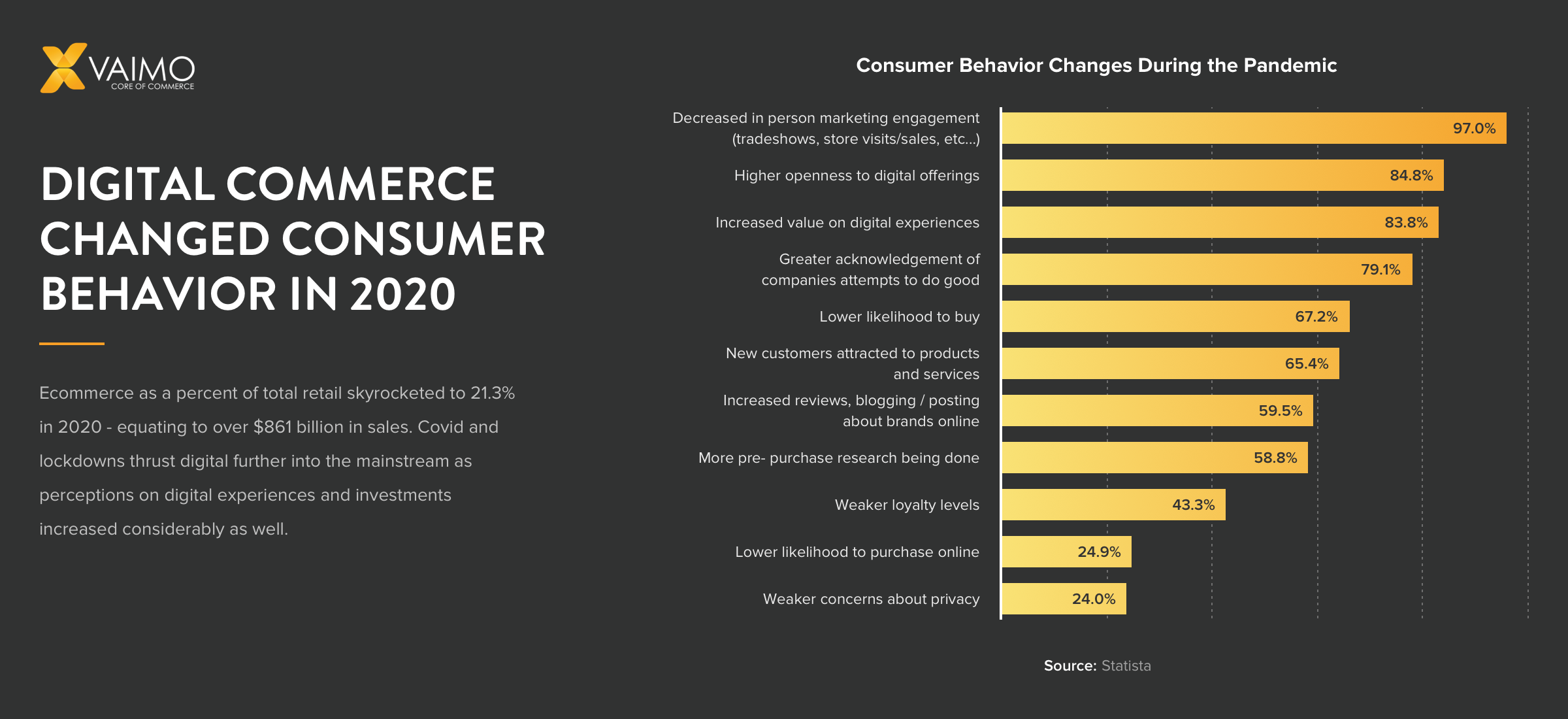It has been a long time since the inception of online shopping. Amazon first entered the market back in the mid-1990s. However, even by 2010, only 6.4% of retail sales were made online in the U.S. In 2019, that percentage had slowly increased to reach 15.8%. By 2020, U.S. eCommerce sales as a percent of total retail sales skyrocketed to an incredible 21.3%, equating to over $861 billion in sales.
There is little mystery to this incredible shift in buying habits. In a matter of weeks, the world was brought to a complete halt. People were suddenly advised to remain in their own homes, and, while shopping habits changed due to COVID-19, they didn’t disappear.
Instead, digital commerce changed consumer behavior in 2020, and it changed it in a way that there is doubt whether we will ever fully return to a pre-COVID lifestyle.
For businesses looking to build a successful digital commerce strategy in the years ahead, it is critical to understand what has changed, how behavior is continuing to shift, and what your business must focus on to successfully meet consumers where they are — online.

1. Virtualization Virtually Overnight
In January 2020, people around the globe were going about their day-to-day lives as usual. By March, people were panic-stockpiling toilet paper, wiping down every surface with Lysol, and fighting the panic of what the days ahead might hold.
Virtually overnight, in-store and on-premise experiences were prohibited. Savvy brands recognized the need to virtualize quickly as frantic buyers turned to their phones to purchase the goods they needed.
Instantly, we saw brands such as Kroger, Walmart, and Dick’s Sporting Goods rise up with new curbside and front-door delivery options. New parking spaces popped up around our cities marked with “To-Go Only,” and, in the blink of an eye, omnichannel B2C commerce became central to the success of any brand. The businesses that moved quickly won hugely. These companies were able to rapidly tap into the shifting landscape profiting off of smart moves into the omnichannel sphere.
2. Forced Consumer Adoption
According to the innovation adoption curve posited by Everett Rogers, there will always be a group of innovators and early adopters who make up a small percentage of our population. These folks are willing to try new things and are likely to be the first to sign up for new technology when it arrives.
However, 2020 did something interesting to this adoption curve. It created a sort of forced trial for many consumers who may have normally been late majority or even laggard adopters.
From farmers who suddenly had to learn how to order inputs from their local retail store online to busy moms who needed to order groceries through their mobile devices, people who once held back from taking an omnichannel approach to shopping were forced into the process.
The end result is that many of these consumers are never going back. For certain categories, such as groceries, curbside and front-door delivery are simply the new norm.
3. A Mobile-Centric World
For a long time, giants such as Google have insisted on the importance of mobile-friendly websites with their algorithms offering preferential search treatment to those who embrace the mobile first world.
Today, this is more important than ever. Mobile shopping has hit an all-time high and is projected to take up 53% of total eCommerce sales by 2024. With the pandemic forcing shoppers to stay at home, consumers are glued to their smartphones and tablets in an almost manic way.
To create a successful B2C or D2C eCommerce strategy, businesses must embrace a mobile-friendly platform.
4. The Addiction of Notifications
In a recent Netflix original, “The Social Dilemma,” experts discuss the addictive quality of the notifications we receive on our phones. These notifications are designed to keep users engaged. Rather than allowing a consumer to simply log into a platform when they think about it, in-app notifications draw consumers back into a platform throughout the day.
Our phone dings, a red circle with a number in it appears, and we become trained to check the notification instantaneously. This creates a hardwired habit that is nearly impossible to break.
For businesses looking to increase online sales, it is important to understand that consumers are now trained to expect offers, notifications, and in-app coupons.
In fact, 35% of shoppers check their phones more than 50 times per day. If you’re not getting your offers in front of your audience’s face, it might be time to create a notification-heavy strategy . . . cue, habit, reward!
5. A Shift in Curbside Ideology
Until the pandemic hit, most people did not spend a lot of time picking up goods curbside. Not only that, but many retailers were hesitant to offer curbside pickup, as this removed the chance to interact with customers and entice them to purchase more.
However, the pandemic did something that motivated all retailers to consider an omnichannel approach — it threatened revenue. With revenue on the line, retailers changed their tune about curbside pickup with all major players entering the game.
6. COVID-19 Delivers a Touch-Free World
Not only did curbside pickup become a staple of a post-COVID-19 world, but so did a demand for touch-free options across the board. Touchless payment methods are highly beneficial in a time when consumers are becoming increasingly conscious of the role surfaces can play in the transmission of disease.
According to the National Retail Federation, since January 2020, the use of no-touch payments saw a 69% increase.
As consumers were forced to adopt more COVID-safe practices, many found they actually preferred these methods. Businesses need to offer simple, fast, touch-free options for accepting payment from customers to meet this increasing demand.
7. A Rise in Payment Plans
From purchasing makeup to buying a new pair of hiking boots, buy-now-pay-later plans are booming. In fact, in our COVID-19 economy, nearly half of consumers cite buy-now-pay-later plans as integral in deciding how much to spend.
Unfortunately, the pandemic took a toll on the economy, and many people have faced job loss. In fact, the unemployment rate peaked in April 2020 at 14.8%, a level that has not been witnessed since data collection began in 1948.
Buy-now, pay-later plans have offered consumers the chance to continue to make important purchases even during economically difficult times.
8. Delivery Expectations = Now
Another behavioral shift during 2020 is consumers’ expectations in regards to delivery. Amazon was the first retail giant to change the game regarding shipping expectations with its Prime two-day delivery.
Today, consumers expect even more. In fact, more than 90% of consumers would love free one-day delivery by any means possible. Additionally, the same study revealed that 86% of consumers also feel that retailers should offer them the ability to choose the most convenient delivery window for their needs.
9. Real-Time Tracking
Remember in 2008 when Domino’s changed the pizza game by offering its revolutionary “Pizza Tracker”? This real-time tracker lets hungry consumers watch as their pizza progresses from creation to baking to delivery. Today, Domino’s has increased their offerings to include GPS tracking, which allows those eagerly awaiting their pizza delivery to see exactly when it will arrive on their doorstep.
Domino’s isn’t alone in this offer. Amazon now offers GPS tracking on many orders, as do most package shipping companies.
For businesses looking to tap into the omnichannel market, real-time tracking is a must. In fact, 97% of customers want to track their orders and receive communications throughout the entire shipping process.
10. A Return Hurdle
While many consumer behavior changes from 2020 have led to new opportunities for businesses to enter the digital-commerce sphere, some have added their own set of hurdles.
Many consumers have adopted an “I’ll just return it” mentality, which can cause a large problem for retailers. The share of online purchases that are returned averages 30% or higher, depending on the category — three times the rate in physical stores — according to industry executives. This can be highly problematic for businesses, such as Dell, Yeti, Harbor Freight, and others that often see consumers make quick purchases but also see an influx of returns.
For this reason, whether B2B commerce or B2C, retailers have to think strategically about how they will handle returns and how they will mitigate this issue before it arises.
Vaimo
While retailers scrambled to adapt in 2020, consumers were spending all that extra time at home refining their online shopping skills. If customers weren’t shopping around before, they are now.
Not only that, but expectations for intuitive shopping experiences are at an all-time high.
And you’re not just competing with others in your industry. Your site’s ease of use is being compared to every other digital platform out there — from Netflix to Spotify to Amazon. This is why it is critical to create a holistic digital commerce strategy for your business. B2C commerce and D2C eCommerce are never going to look the same after the behavioral shifts of 2020.
At Vaimo, we specialize in helping businesses build an optimized online customer experience. Whether you are looking to create a D2C marketing strategy or are simply interested in learning more about what an omnichannel strategy would look like for your specific business, we can help in the following ways:
Delivery Options
As demonstrated above, consumers demand fast delivery options and real-time tracking. Our team can help you build a feasible delivery strategy that will meet the demands of today’s consumers.
Omnichannel Experiences
Perhaps up until now, you have engaged in a multichannel approach to digital commerce. This approach might include an online storefront, a physical shop, and a phone number where someone can call you to place an order.
However, a multichannel strategy does not meet the new behaviors of consumers in 2021. Rather, it is important to design an omnichannel experience where every component of your business is tied together in one cohesive manner.
Mobile Focused
With so many consumers glued to their phones, it is more critical now than ever before for businesses to adopt a mobile-focused eCommerce strategy. From implementing notifications to creating a mobile-friendly website, our team can help you strategize how to best meet your customers through their mobile devices.
Flexible Payment Options
If your business isn’t yet offering a buy-now-pay-later plan, it is time to explore flexible payment options. Consumers still want to make purchases, but their budgets might not be the same as in 2019.
Creating a strategy around payment plans is critical for reaching your consumers in today’s post-COVID market.
Strategy Backed by Best Practices
Finally, at Vaimo, we pride ourselves on the fact that we offer B2C and D2C commerce strategies that are backed by data and best practices. We will work with you to understand your consumers better, utilizing cutting-edge metrics and data analytics. From here, we will build a custom strategy for your business, testing out the best methods for increasing your company’s revenue.
2020 changed consumer behavior in a meaningful way. At Vaimo, we are here to help you meet today’s consumers where they now reside.
Talk to our team about building an omnichannel strategy that will adapt to the behavioral trends of today and tomorrow.






